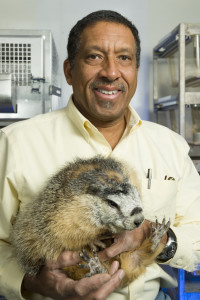Most people only think about groundhogs on February 2 when the legendary Punxsutawney Phil emerges from hibernation and looks for his shadow.
(Lore holds that if he sees his shadow, we can expect six more weeks of wintery weather. If he doesn’t, we can expect an early spring.)
But Gregory Florant, a professor of biology at Colorado State University, studies them year-round. He has performed research on groundhogs and marmots and is considered an expert on the animals.
In honor of Groundhog Day, we sat down with Florant and asked him about his research.
How long have you been researching marmots and groundhogs? 40 years
How did you get into the field? I did my doctoral thesis on temperature regulation in marmots and continued to study them.
Why research marmots? They have some of the most extreme physiological behaviors known to mammals. One, they don’t eat for nearly 7 months and survive. 2) they allow their body temperature to drop near zero degrees, 3) They have evolved different social behaviors.
What is the focus of your research? I study how these animals gain and lose mass in the form of fat. In addition, I study how their energy metabolism changes seasonally.
Why is it important? What can we learn from these animals? Obviously, obesity is a big human problem. If we can understand how other mammals regulate their food intake and body fat, particularly hibernators, we might help the human condition. By studying them, we can gain a better understanding of mammals regulate food intake and energy metabolism. This has implications for many human diseases including diabetes and obesity.
Are marmots and groundhogs the same? No, they are actually separate but very closely related species.
How do they wake Phil from hibernation so he can “see” his shadow? They pull him from an artificial burrow.
Can you tell us some fun or unusual facts about groundhogs and marmots? They can fast for 7 months! They can climb trees. Some species like to huddle- with more than 50 individuals– in one huge burrow during their hibernation season, which is in the winter.